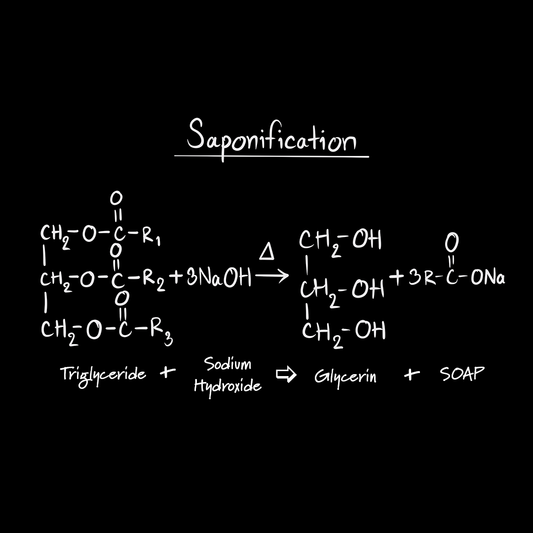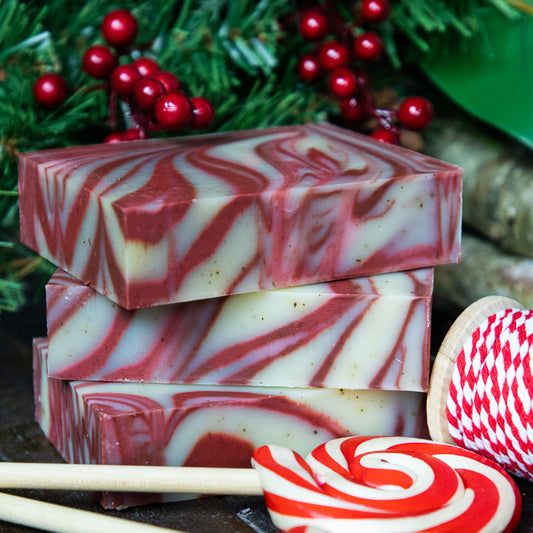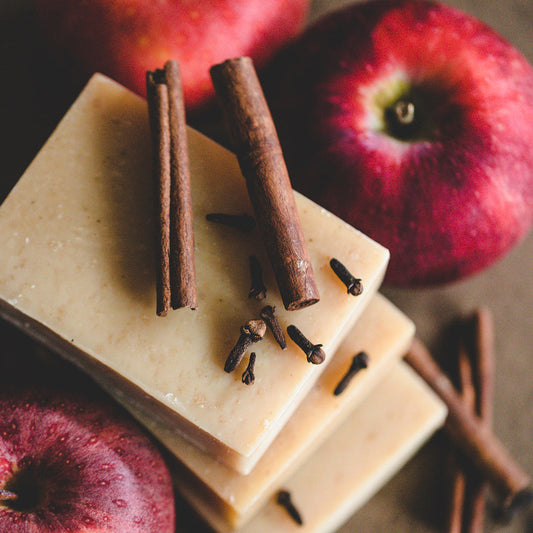What is Glycerin Soap?
We are often asked, "Do you make glycerin soap?" or "What's the difference between your soap and glycerin soap?"
The term "glycerin soap" is a misleading term. All cold-processed handmade natural soap, made from scratch, is glycerin soap.
The diagram of saponification shows the chemical reaction that produces soap. You can see from the diagram that glycerin is on the right side of the reaction meaning that it is a natural byproduct of the natural soap-making process.
When we mix Fat (plant oils or butters) with Sodium Hydroxide the result is Soap + Glycerin + a bit of water.

Glycerin is in natural soap as a result of saponification, it is not added to the soap. As a result you will NOT see the word "glycerin" in the ingredient list on a bar of natural soap.
While all of the moisturizing glycerin remains in a bar of natural made soap, most commercial soap manufacturers remove the glycerin and sell it to other companies or use it themselves to create products such as moisturizing lotions.
Our moisturizing cold processed natural soaps and shampoo bars have a naturally high glycerin content.
You may notice that when our natural soap sits out in humid conditions, it will shimmer with beads of moisture. The glycerin, a humectant, in the soap will draw the moisture out of the air and onto the soap.
When used topically, glycerin can draw moisture from the atmosphere onto the skin and create a barrier that locks in existing moisture. This makes it one of the most widely used moisturizing ingredients in personal care products.
For more about the chemical process of making soap please read, "Is There Lye In Natural Soap? Won't It Harm My Skin?"
So, What Is Glycerin Soap?
![]()
 What most people refer to as glycerin soap is a gel-like, dense, translucent bar that is thought to be good for people who have sensitive skin.
What most people refer to as glycerin soap is a gel-like, dense, translucent bar that is thought to be good for people who have sensitive skin.
While it is also real soap, this transparent soap goes through a process in which regular soap batter is continuously heated with sugar, alcohol, and some extra added glycerin until the mixture reaches a clear, jelly-like consistency.
The alcohol prevents the soap from crystallizing so the soap remains clear and the extra glycerin balances the drying nature of the alcohol.
A true glycerin soap contains alcohol along with the usual ingredients needed to make soap; oils, water, and lye. While some transparent glycerin soaps are made with natural ingredients, others contain synthetic foaming agents and detergents, as well as synthetic colors and fragrances.
If a bar of glycerin "soap" claims to be made without "soap" then it must be made with synthetic surfactants in order to give a glycerin “soap” bubbles and cleansing power.
Although I have seen soap labeled as "100% glycerin soap," or "Pure Glycerin Soap," soap CANNOT be made with only glycerin -- it is chemically impossible and would have no lathering or cleansing properties.
Unfortunately, there is no real definition for "glycerin soap." When you see those words on a package it can mean anything from real soap that retains its natural glycerin, to the transparent soap described above, to synthetic detergent bars containing glycerin.
What Is Glycerin?
 Glycerin, also known as glycerine or glycerol, is a naturally occurring component of triglycerides (fats and oils).
Glycerin, also known as glycerine or glycerol, is a naturally occurring component of triglycerides (fats and oils).
It's a clear, colorless, odorless, and syrupy liquid with a sweet taste and was first discovered in 1779 by the Swedish chemist, Karl Wilhelm Scheele, who named it the “sweet principle of fat.” In 1811, Michel Chevreul, a Frenchman, named it glycerin, which comes from the Greek word "glykys" meaning sweet.
Glycerin is a humectant that absorbs water from the air and attracts moisture to your skin, making it a very effective moisturizer.
Glycerin was mainly utilized for medicinal use and personal care until the late 1800’s when Alfred Nobel discovered the significance of nitroglycerin as an explosive.
The demand for glycerin turned soap manufacturing into a very profitable business. Sadly, businesses wanted the glycerin, not the soap!
As a result of the need for glycerin to make nitroglycerin (used to make dynamite), a practical method for extracting glycerin from soap was invented. Until the 1940s, most glycerin was produced as a by-product of soap manufacturing. Then a method to create glycerin synthetically from propylene glycol, a petroleum byproduct, was developed.
So, glycerin no longer comes only from soap. It can be obtained from plant oils, animal fats, and synthetic chemical sources like petroleum.
Unfortunately, when glycerin is added as an ingredients to a personal care product, commercial manufacturers do not usually disclose the source of the glycerin in their ingredients list.
Today there is still a profitable market for the glycerin which is separated from soap. Commercial soap manufacturers harvest the glycerin from their soaps to use in products that command a higher price, like the creams and lotions that you need after using their soaps that dry out your skin!
So when we are asked, "do you sell glycerin soap?”
The answer is "Yes!" Since we do not remove the natural glycerin from our soap, we sell glycerin soap.

How We Make Soap At Chagrin Valley Soap
How Does Natural Soap Create Lather?
12 Reasons To Use Natural Soap


